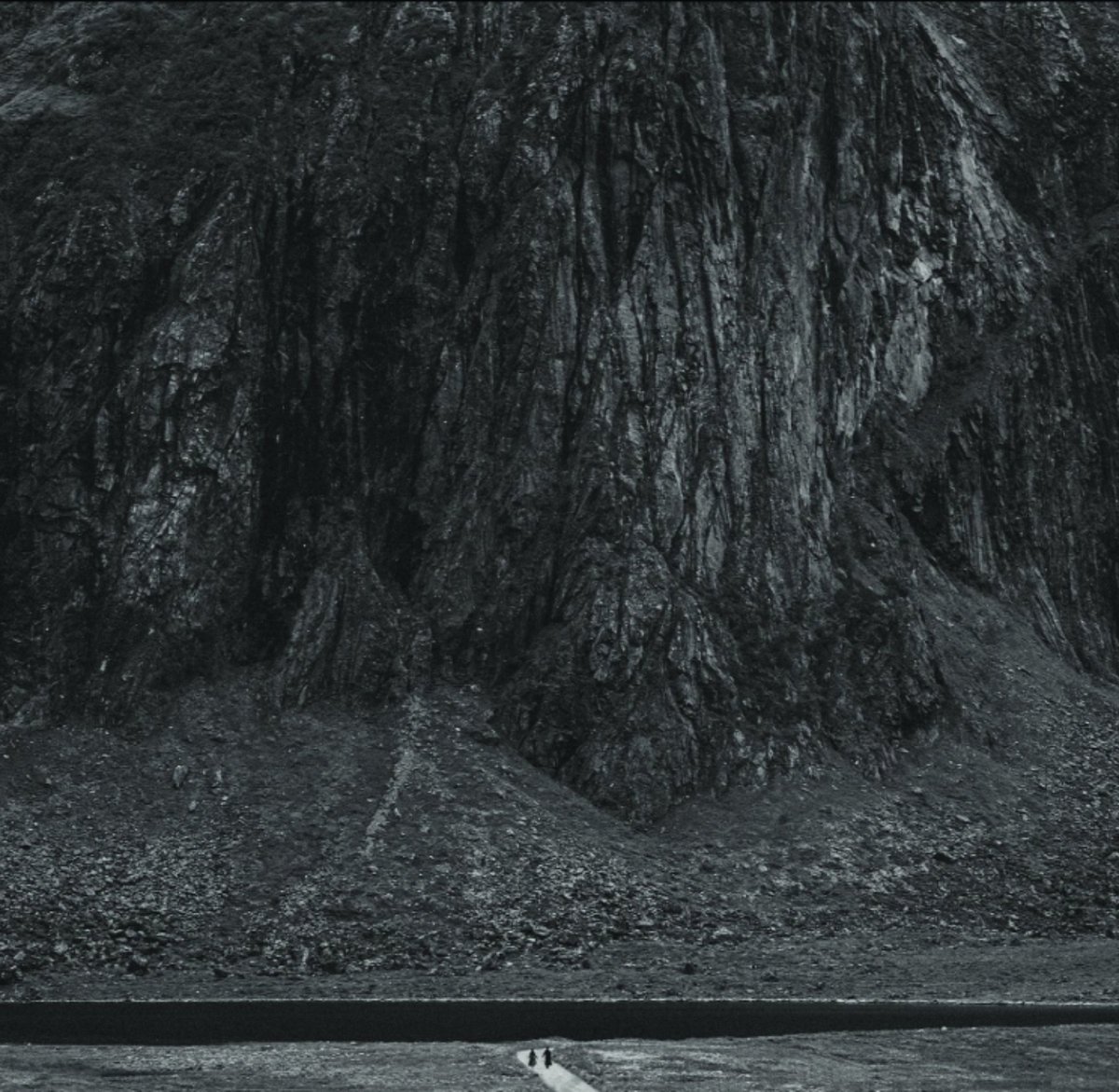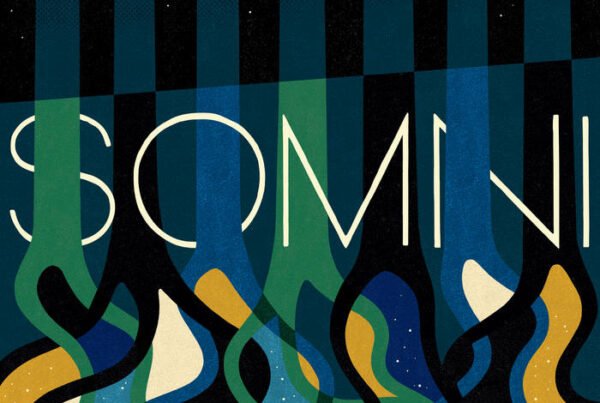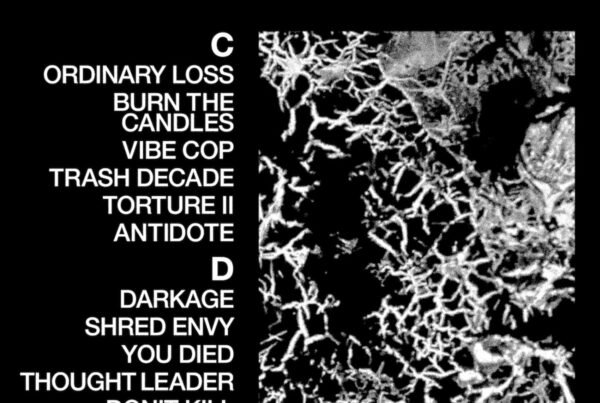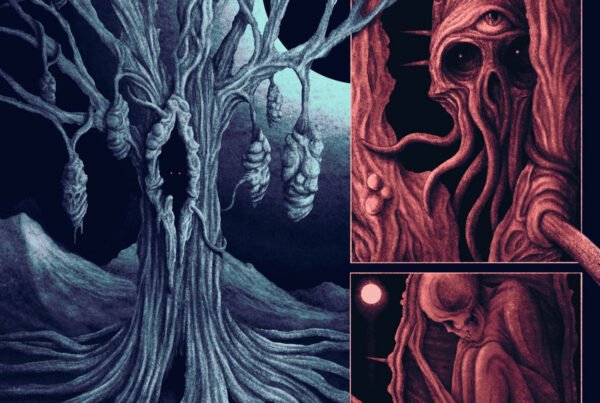On their quest to evoke the ultimate despair, Defacement have crafted a trial of extraordinary pain and beauty
Release date: August 22, 2025 | Avantgarde Music & Total Dissonance Worship | Bandcamp | Instagram
Heartless, mindless, unfathomable. The cliff face looming impossibly high and wide, jagged cracks casting hatred on the river below. Scree sloping down to the water, foretelling collapse. On the other side, barely visible, the only opposition: two small smudges suggest human forms. They face the cliff, and any parley or plea is pulverized in the warcry of stone.

Defacement make a harrowing statement with the cover of their fourth album, a photograph by Kjetil Karlsen. Where Defacement (2021) and Duality (2024) displayed images of literally de-faced people, Doomed bucks death metal expectations for this vision of pure, total adversity. Any self-identification with the figures in the frame hints at titanic awe, fear, and futility. Looking closer at the album, song titles and lyrics (available on physical release only) dig deeper into that sentiment. They describe a joyless existence, alienated from others to the point of solipsism. Self-disgust runs so deep that even looking at a mirror causes an existential crisis. All efforts to reason with the meaninglessness of life return only more confusion and dismay, and that is where the colossal enemy lies: in existence’s own absurdity.
Defacement’s music has always been very personal, a creative outlet for deep-seated, painful emotions. These muses come primarily from guitarist Khalil Azagoth and vocalist/bassist Forsaken Ahmed, who both emigrated from Libya to study in Ukraine, and later moved to the Netherlands. In a 2022 interview with Aristocrazia Webzine, Khalil shared the struggles the two have faced in Europe, being antagonized by religious and political groups and the like, and how these experiences fueled the anguished tones and lyrics on 2021’s self-titled. Between then and the release of Doomed, these feelings seem only to have intensified. In the notes on the album’s Bandcamp page, a bandmember, likely Khalil, directly states to the listener that he wrote it in a state of ‘psychological collapse’ and that ‘these are wounds speaking.’ He also says ‘[I] exist to make you hate your existence.’
Understanding now that this album is truly no joke and is intended to transfer psychological distress directly onto the listener, we can discuss the music and its differences from previous Defacement releases. Let’s start with similarities. The band’s fundamental sound is still the most extreme assault of dissonant blackened death metal they can conjure. Guitars screech in chalkboard tremolo atop searing blast beats, drowned in a cavernous death growl sea. It’s not a wall of sound, but a deluge. Then it switches up. One guitar churns angular atonal riffs while the other jumps up to a wailing car alarm, the drums play a different form of blast beat, and the vocals rise to a howl. These kinds of brutal sounds and jarring switchups are all over Doomed, and Defacement execute them with the same prowess as ever.
I would even argue that Doomed is more aggressive and technically impressive than its predecessors. There is a murderous attack to the riffs, like a barrage of falling boulders, where previous albums focused more on creating atmosphere. There are also added dissonant guitar sweeps à la Gorguts and some flashy guitar solos and licks. What’s most impressive about the aggression though is that it gets more intense as the album continues. “Portrait” is the first metal song on the album, and it is a roiling vortex of dissonant agony with little relief. Few bands are capable of that level of brutality, but the harshest dissonance on the album comes later, at the beginning of “Worthless”. Even then, Defacement keep more in reserve, because the heaviest moments are in the final song, “Absent”. Their ability to continuously top themselves in this way is astounding, and it does a lot for their goal of psychically wounding their audience.
In my opinion, however, the most interesting component of Doomed is its use of melody, and this is paradoxically the most melodic Defacement album so far. The most stand-out melodic moments are the three interludes, which are immersive and beautiful. Defacement love their interludes, and this time around they act as lamentations, remembrances of a more simple time. “Mournful”, the opening track, begins with a low rumbling sound, countered by angelic synth and singing. It is as if the great cliff has finally collapsed, and a choir of seraphim calls through the bombardment to mourn the doomed souls below. Later, “Forlorn” has a very similar effect, but on “Clouding” the angelic voices have disappeared, as if even the ability to remember past joys has been obscured by suffering.
Defacement lean hard into melody in the songs themselves as well, and create emotional moments amid their dissonant insanity. Many of the songs spend as much time in consonance as they do in dissonance. “Unexplainable” is the first to do so. In its first half, harmony and chaos take turns, often overlapping, and the second half is a gradual melodic rise to a sublime crescendo. “Unrecognized” and “Absent” end in similar ways, and each is more euphoric than the last. It is uncharacteristic for Defacement to spend several minutes on melodic sounds in any song, let alone multiple on an album, and it’s even stranger on an album whose stated goal is to cause suffering, but it creates a helpful sense of balance in Doomed. Every song is a harsh experience, and every one has a linear, wandering structure that can make one feel lost. The presence of legitimate beauty shines a light on the madness that rewards our perseverance, and makes the darkness hit all the stronger.
Doomed is yet another powerful addition to Defacement’s discography. They have managed to outdo their own dissonance and brutality, which makes this easily one of the most punishing death metal albums of the year. This aligns with the heightened themes of utter hopelessness here. At the same time, they have also imbued this album with the most extensive, cathartic melodicism of any of their releases. It’s puzzling how the artists themselves describe this album as the reflection of complete psychological defeat, yet several moments convey peace or triumph. I see this conflict as another layer to peel back in a thematically profound record. Defacement have used dissonant death metal as a foundation for something greater this time around, and they continue to restyle the possibilities of what this genre can achieve.
TL;DR: This is the most punishing and dissonant Defacement record yet, but also somehow their most melodic. It has genuine beauty even as, in the artist’s words, it is intended to cause suffering. It might be their best yet.






